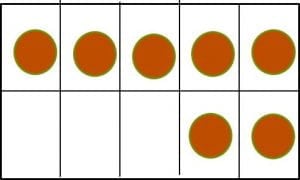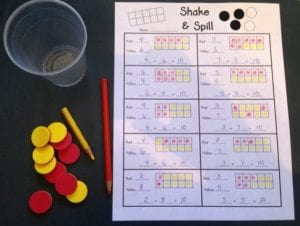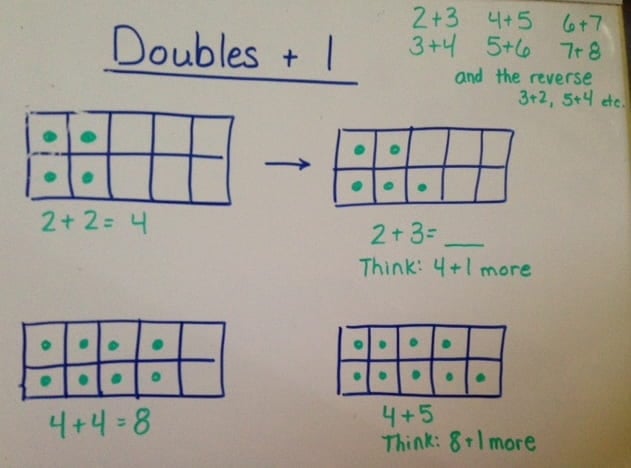by C. Elkins, OK Math and Reading Lady
Last week’s focus was on using ten frames to help with students’ number sense and conceptual development of number bonds for amounts 1-10.  This post will feature ways to use ten frames to enhance students’ understanding of addition and subtraction. Look for freebies and a video!
This post will feature ways to use ten frames to enhance students’ understanding of addition and subtraction. Look for freebies and a video!
There are many addition and subtraction strategies to help students memorize the basic facts such as these below. The ten frame is a very good tool for students of all grade levels to make these strategies more concrete and visual. I will focus on some of these today.
- add or take away 1 (or 2)
- doubles, near doubles
- facts of 10
- make a ten
- add or sub. 10
- add or sub. 9
- add or sub. tens and ones
Doubles and near doubles (doubles +1, -1, +2, or -2): If the doubles are memorized, then problems near doubles can be solved strategically.
- Show a doubles fact on a single ten frame (for up to 5 + 5). Use a double ten-frame template for 6 + 6 and beyond.
- With the same doubles fact showing, show a near doubles problem. This should help students see that the answer is just one or two more or less.
- Repeat with other examples.
- Help student identify what a doubles + 1 more (or less) problem looks like. They often have a misconception there should be a 1 in the problem. Make sure they can explain where the “1” does come from. Examples: 7 + 8, 10+11, 24+25, 15 +16, etc.
- For subtraction, start with the doubles problem showing and turn over the 2-color counters or remove them.
Facts of 10: These are important to grasp for higher level addition / subtraction problems as well as rounding concepts.
- Place counters on the ten frame. Determine how many more are needed to fill in the ten frame. This also helps with missing addends. Example: 3 + ___ = 10. Ask, “What goes with 3 to make 10?”
- Using 2-color counters, fill the 10 frame with 1 color. Then turn over some to reveal a number bond of 10 (such as 4 and 6).

Shake and Spill
- Play “Shake and Spill” with 10 two-color counters. Click on these links for Shake and Spill Directions and a Shake and Spill recording page. Basically, the student puts 10 of these counters in a cup, shakes it, and spills it out (gently). Count how many red and how many yellow. Repeat 10 or more times. Keep track of the spills on a recording sheet. Which combination came up most often? Which combination never came up? What is really nice to observe is if a student spills counters and sees 6 are red, do they know automatically there are 4 yellow, or do they still have to count them?
- Since number bonds enable a student to see addition and subtraction problems, the second bullet above will serve subtraction problems very well. Start with 10, turn over 7 to the yellow side. How many counters are red?
Make a Ten: This strategy builds on the above (facts of 10) to help with problems with sums between 10 and 20. Students should readily be able to solve a problem such as 10 + 4 mentally first.
- Use 2 ten frames (see Ten Frames part 1 for a link for templates)
- Let’s say the problem was 8 + 5. Place 8 counters on one ten frame, place 5 on the other.
- Move counters from one ten frame to fill up the other. 8 + 5 is the same as 10 + 3. The problem 10 + 3 should be a mental math problem. Students will need to see that counters were not added, but shifted from one ten frame to the other.
- Repeated practice with this concrete activity helps children think more deeply about the relationship of numbers.
Continued practice with these strategies:
- During your daily math meeting, flash ten frame dot cards to students in which they must use the above strategies. Use it as a # Talk sessions so students can verbally explain how they solved it.
- Try this from NMCT Illuminations sight (National Council for Teachers of Mathematics): Interactive ten frame
- Watch this video of a teacher modeling the Make-a-Ten strategy: Make a ten video using ten frames
- Learning stations:
- Play Shake-n-spill (links above)
- With a blank ten frame, create doubles and near doubles problems. Or look at flash cards and make those problems.
- Show a partially filled in ten frame. Student must tell their partner how many more are needed to fill it in.
- Give students flash cards for problems with answers between 10 and 20. Show each addend on a ten frame and use the make-a-ten strategy.
Share your experiences with ten frames!



